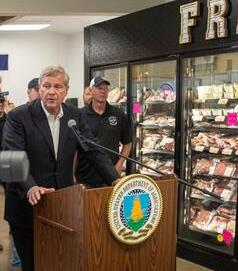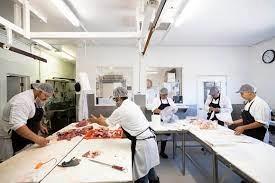 Secretary of Agriculture, Tom Vilsack, has announced grants totaling $200 million under the Meat and Poultry Intermediary Lending Program intended to “strengthen the food supply chain and create opportunities for small businesses and entrepreneurs in rural communities.”
Secretary of Agriculture, Tom Vilsack, has announced grants totaling $200 million under the Meat and Poultry Intermediary Lending Program intended to “strengthen the food supply chain and create opportunities for small businesses and entrepreneurs in rural communities.”
Clearly, this amount sprinkled in small grants to nonprofits, cooperatives and tribal entities will do very little to increase meat supply to the Nation. The Department of Agriculture under its current leadership has a misplaced preoccupation with promoting production through any number of small-scale producers. In his previous tenure as Secretary of Agriculture, Vilsack demonstrated an animus towards corporate entities that have followed a path towards consolidation and the establishment of large and highly efficient processing facilities. The red meat industry is, to a large extent, fragmented given that the beef industry comprises independent sectors extending from cow-calf operations through to feed lots and culled dairy cows supplying packing plants. In contrast the broiler and turkey segments of the poultry industry are integrated and less consolidated than beef and pork processing.
Political appointees in the USDA apparently have no grasp of the needs for both fixed and working capital to operate an efficient packing enterprise. Processors to be successful must establish product diversity and distribute beef and pork to the domestic retail market and for export. A $15 million loan to acquire land, build or expand facilities or even to modernize equipment is a drop in the bucket compared to the capital cost of a large-scale beef or pork plant that may approach $1 billion. A proposed beef packing plant in Rapid City, SD. intended to process 8,000 head per day employing 2,500 workers will require an investment of over $1.1 billion. The capital cost per unit of production declines and the productivity of each worker increases with scale of operation.
 We are supposed to function in a free enterprise, economic system that is in large measure governed by the laws of supply and demand. Attempts to manipulate production or processing by scattering grants to socially disadvantaged and recipients unqualified to obtain commercial loans may well be a waste of public funds without providing benefits to either farmers or consumers. Unfortunately, there are apparently many political appointees within the USDA with public funds at their disposal to implement socio-agronomic policies that fail to take into account the commercial realities of the red meat and poultry industries.
We are supposed to function in a free enterprise, economic system that is in large measure governed by the laws of supply and demand. Attempts to manipulate production or processing by scattering grants to socially disadvantaged and recipients unqualified to obtain commercial loans may well be a waste of public funds without providing benefits to either farmers or consumers. Unfortunately, there are apparently many political appointees within the USDA with public funds at their disposal to implement socio-agronomic policies that fail to take into account the commercial realities of the red meat and poultry industries.
In contrast to pork and beef production, the broiler industry is highly integrated and has grown in output at the expense of both red meat sectors, through the principle of efficiency of scale, and applying scientific advances in genetics, nutrition and flock health. This has allowed an expansion of output through investment and the coordination of production and marketing for both export and domestic consumption. The Lincoln Premium Poultry complex located in Fremont, NE. and established by Costco to produce two million standard rotisserie-sized chickens each week required an investment of close to $500 million for a plant, feed mill and hatchery.
Comrade Vilsack and his acolytes should most certainly not interfere in what can be regarded as the most efficient sector of animal protein production. If inappropriate regulation is forced on the poultry industry, growers, shareholders of major companies and consumers will suffer.
It isn’t broken, so please it doesn’t need fixing.